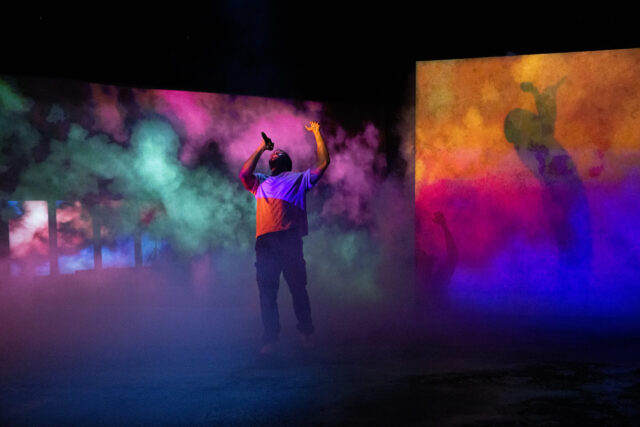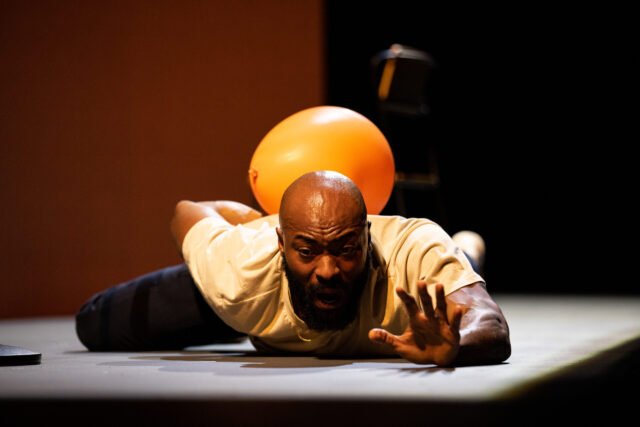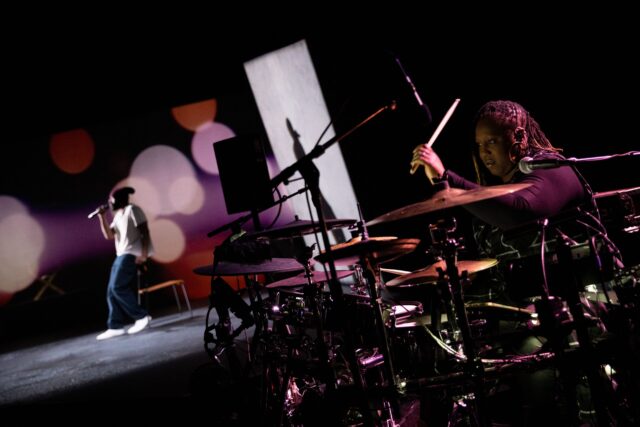
Arinzé Kene’s Misty is making its North American premiere at the Shed (photo by Maria Baranova / courtesy the Shed)
MISTY
The Griffin Theater at the Shed
The Bloomberg Building at Hudson Yards
545 West 30th St. at Eleventh Ave.
Tuesday – Sunday through April 2, $29-$88
646-455-3494
theshed.org
On opening night of Arinzé Kene’s thoroughly inventive and unpredictable Misty at the Shed, the fashionable crowd sipped wine and cocktails as photographers snapped pictures of attendees posing in front of large orange balloons and balls. The balloons and balls are key props in the show, which debuted at the Bush Theatre in London in March 2018 and moved to the prestigious West End that September. The play is a screed against gentrification, what Kene calls “virus invasion . . . modern day colonisation,” in addition to being a fascinating exploration of the creative process itself. Although it is set in London, its themes relate directly to New York City.
In the first scene, Arinzé, standing front and center at a mic, raps, “Here is the city that we live in, / Notice that the city that we live in is alive, / Analyse our city and you’ll find, that our city even has bodily features, / Our city’s organs function like any living creature, / Our city is a living creature, / A living breathing city creature broken into boroughs, / Mostly living creatures are broken into organs, / For the city creature each borough is an organ, / And if we’re saying that the boroughs be the organs now, / You might liken the borough that I live in to the bowel.” A few beats later he adds, “But all is well, / Cos blood cell to blood cell there’s nothing to fear.”
His character is a virus battling against the red and white blood cells, trying to survive in a city undergoing urban renewal, a Black artist getting lost in a world being reconstructed around privilege.
A fight on the night bus sends him on the run from the law, hiding and finding out who his friends are. The story is inspired by something that happened to his childhood friend Lucas; about halfway through the play, we hear a recording of Arinzé talking to Lucas, who promises to “keep honest.”

Balloons thwart Arinzé Kene throughout Misty (photo by Maria Baranova / courtesy the Shed)
Meanwhile, Arinzé is writing the play about the virus and blood cells, hitting various obstacles, including criticism from two of his closest friends, Raymond, a chef, and Donna, a schoolteacher, a married couple portrayed respectively by keyboardist Liam Godwin and drummer Nadine Lee, who perform on opposite ends of the stage, flanking Arinzé. Rajha Shakiry’s set features angled empty frames and cubes sinking underground and a long, rectangular translucent screen with silhouetted furniture behind it. Daniel Denton’s often psychedelic, abstract projections and shots of empty city streets appear on multiple surfaces.
Arinzé uses the structure of the play to comment on Black performance itself, and his narrator suffers a crisis of confidence when Donna and Raymond attack his work-in-progress, calling it a “ni–a play.” Donna thinks it is yet another show about a “generic angry young black man!” written for white people. “I looked around and most of the audience were . . . most of them don’t look like us,” Raymond points out. “They seemed to love it!” Donna adds. Raymond continues, “As soon we walked out Donna turned to me and said ‘Arinzé sold out and wrote a ni . . . an inner city play.’” Donna corrects him, “Nah that’s not what I said. I said ‘Arinzé sold out and wrote a ni–a play.’ You wrote a ni–a play so your work would get put on.” Raymond concludes with a sly note: “The two musicians were dope though.”
As the virus runs for his life and Arinzé gets feedback from his producers (existing audio clips from a pair of very famous speakers) and a little girl (either Ifeoluwa Adeniyi or Braxton Paul) — in addition to several hilarious appearances by the stage managers — Arinzé becomes swamped by orange balloons and rubber balls, surrounded and trapped by the blood cells attempting to destroy what they believe to be a dangerous contagion.
Imaginatively directed by Omar Elerian (Nassim, Islands) with artistic flair — there’s something new to see and hear in every scene, the names of which include “City Creature,” “Locked Out,” and “Jungle Shit” — Misty is a thrilling theatrical experience, loaded with surprises around every corner. Jackie Shemesh’s lighting is bold and provocative, while Elena Peña’s sound ranges from prerecorded messages to Arinzé, Shiloh Coke, and Adrian McLeod’s score, which jumps from subtle, soothing synths to propulsive thumping.

Drummer Nadine Lee also portrays Donna in Misty (photo by Maria Baranova / courtesy the Shed)
Kene (One Night in Miami, Get Up Stand Up!) is a sensational performer, whether rapping, delivering self-deprecating jokes, or fighting a giant orange ball. The play works best when he stays on his metaphorical journey and avoids delving into clichéd and overt sociopolitical rants, which pop up in the second act. (The play feels slightly too long and repetitive at two hours with intermission.)
He effectively argues, “When a virus shakes up a blood cell, the organ doesn’t cope well, the city creature goes pale, the body’s feveral, / Antivirals administered by hypodermic needle go on patrol, in search of us virus people, / As they police through the blood vessels, we scatter like roaches, we scuttle into the shadows like beetles, / They don’t want us roaming in the city creature, they don’t want us multiplying, they don’t want an upheaval.”
Kene is well aware of the jeopardy Black bodies face, and one of his final gestures onstage becomes a major statement, revealing the physical strength that is still not enough to protect him from constant threat that goes far beyond the night bus.
After the show, the crowd was treated to wine, popcorn, and crudités. I couldn’t help but think of the first monologue, when Arinzé declares, “The doors close, the night bus pulls away, so now there’s no getting off, / And if you’re wise enough! You’ll know not all of us! Aboard this bus! Are blood cells . . . / Nah, / One of us is virus. / Geh-geh.” And then, later, when one of the producers asks him, “Is it just me or does that feel a little excessive?”